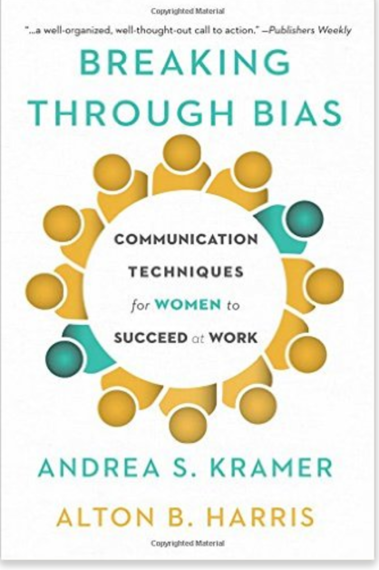Women in the workplace often face an impossible choice between being assertive and perceived as pushy or being conciliatory and perceived as weak. In their book, Breaking Through Bias: Communication Techniques for Women to Succeed at Work, Andrea S. Kramer and Alton B. Harris give practical, specific, advice to help women find a way to speak up, to be heard, and to get what they need for professional and career success. The book is filled with telling real-life examples any woman who has ever had a job will recognize. Men who read the book will also recognize some of the unconscious bias they may be bringing to the workplace.
In an interview, Kramer and Harris answered questions about the challenges women face and how posture, "mind priming," good fathers, and popular culture can help women find their voices.
Is it possible for a woman to find the right place between being perceived as persuasive and being perceived as pushy?
To advance in her career, a woman needs to be perceived as competent, confident, and an effective leader. A woman's problem is that if she behaves precisely as a man with a similar objective would behave, she is likely to be regarded as pushy, aggressive, and unpleasant - in a word, a bitch. So it is important to recognize that a woman's path to the top is not to "act more like a man." Men can advance in their careers with a hard-edged, no-nonsense style that would be a disaster for most women. Different situations call for different leadership styles, but regardless of the situation, a woman seeking to lead needs to project warmth and competence, pleasantness and confidence, inclusiveness and drive. This requires her to carefully manage the impressions she is making on others if she is to have a smoother path to the top.
Are there words that are considered acceptable for men but not right for women? What about the other way around?
Context is everything when it comes to how women are described. For example, in most circumstances to say a man is aggressive is a positive characteristic, while to label a woman as aggressive is usually a negative characteristic. But a woman lawyer who cross-examined a witness was described as aggressive, that would probably be viewed as desirable. Likewise, "tough" is a quality we tend to admire in men but view as undesirable in women. Yet, if a woman is being unfairly criticized and she stands her ground and calmly refutes the accusations, we might very well admiringly say, "She's tough, she can really take it." And a final example might be "dominant," which is typically seen as a very positive quality in a man but unattractive in a woman. Yet, to describe a woman tennis player or negotiator as "dominant," can be a high compliment.
The stereotypical characteristics associated with women and men have a proscriptive quality to them: women should not be assertive or tough because those are male characteristics. Men should not be emotional and caring because those are female characteristics. But remember, stereotypes are just that, stereotypes, and they can always be trumped by context.
What role models do young girls have to show them how to come across as confident and professional? What role models send the wrong messages?
Role models exhibiting confidence and professionalism are very valuable in shaping young girls' outlooks and aspirations. But it is important to recognize that men as well as women can be role models for young girls. A father who is compassionate, considerate, loving, hardworking, and a true domestic partner can have an enormous impact on a young girl's view of appropriate gender roles. A mother who has a full-time career and whose partner supports, encourages, and accommodates her provides her daughter with two role models.
Publicly prominent women who can serve as role models of courage and confidence include Serena and Venus Williams, Megyn Kelly, Angela Merkel, and Hillary Clinton. As for professionalism, Janet Yellen, Christine LaGarde, Samantha Powers, and Ruth Bader Ginsberg are about as professional as anyone gets. But young girls - just like all the rest of us - need a variety of role models with traits they can use to develop a composite image of who or what we want to be like. Perhaps Michael Jordan and Misty Copeland for grit; the three black female mathematicians at NASA featured in the movie "Hidden Figures" for grace under adversity; Martin Luther King for speaking truth to power; Glenna Davis for confronting bias in her own industry; Michelle Obama for elegance, grace, and good taste in everything she says and does; and Sheryl Sandberg, Marissa Mayer, and Meg Whitman for making it in tech, the ultimate male domain.
As for role models that send the wrong message, the public arena is full of them: Phyllis Schlafly for the notion that women and men should play different societal roles and should be criticized and disparaged if they step out of those roles; Donald Trump for the notion that sexist, racist, and religiously intolerant comments have a legitimate place in civil discourse; and Whitney Houston and Prince for the notion that drug and alcohol abuse are "cool."
How can a woman tell in a job interview if the job will provide genuine opportunity and support?
Many businesses are actively trying to recruit women; yet many of these businesses lack the policies, practices, and culture to foster women's growth and advancement. A woman can do several things when considering job offers to increase her chances that the job she takes will provide her with real opportunities and support. First, she should find out as much as she can about the women who are already in the company: what is the attrition rate for women as opposed to men; what percentage of women have line and p&l responsibilities; and how many women are in the C-suite and on the Board. She should ask about formal training, mentorship, and skill-building programs; the assignment, evaluation, and promotion processes; and whether the company has a diversity and inclusion initiative and, if so, how it is structured. Second, she should talk to women at the company about their sense of job satisfaction; investigate how the company is rated as a "good" place for women; determine if any sexual harassment claims have been filed against the company; and assess the reputation of the industry in general with respect to women's success.
What surprised you most in talking to other women about their experiences?
Perhaps the most surprising thing we have heard from women as we have been addressing gender bias across the country is how women see working for or with other women as a difficult workplace problem. Typical comments we hear are: "I'd rather work for a man than a woman;" "Why are women so mean to other women?"; and "I get no support from the senior women in my organization." As we have listened and talked with these women, we have reached two conclusions: First, there most certainly are some women who are unpleasant, disagreeable, and uninterested in helping anyone else - but that there are far fewer women of this sort than there are (percentage-wise) of comparably behaving men. The second is that the primary source of the "woman against woman" problem is gender bias itself. This can take many forms: women may not want to work for other women because the senior women do not conform to the younger women's stereotypical expectation that women should be caring, helpful, and compassionate. Or senior women (often unconsciously) react to the gender bias in their organizations by distancing themselves as far as possible from other women. And in other situations, there may be only one or two "women's seats" in senior management so the women in those seats see other women as direct threats to their positions.
What is the best way to tell a boss -- male or female -- that you believe you are not being treated fairly?
First, let's talk about style not substance. The way in which a woman communicates her sense of unfairness is critical to her presenting a persuasive case. She needs to be direct, calm, composed, and professional. She must not come off as "emotional," "shrill," or "whining." As for substance, a woman needs to focus on opportunity and contribution, not on complaint and accusation. She also needs to have the facts at hand that support her case. Thus, for example, she might say something like, "I know I can make a terrific contribution to the XYZ project (team, initiative, client), but I am not getting the opportunities to do so. For instance, last week Joe and John were picked to do ABC, but I am the one who know the most about ABC. Perhaps I am going about this in the wrong way. How do you think I can demonstrate that I am ready for important, challenging assignments that will allow me to contribute fully to our terrific company?"
What is "mind priming," and how does it help?
Mind priming" is an approach developed by Adam Galinsky, who is now at Columbia University. It is a technique for assuring that when you go into a high-stakes or high-stress situation, you do so with a very explicit and positive sense of your competence and confidence. The basic idea is to write for five minutes or so about an occasion when you felt especially powerful, happy, or proud. The research makes clear that by doing this immediately before a meeting or presentation you will perform - and be perceived as performing - far more effectively than you otherwise would.
How does posture convey authority and capability?
When we hold certain poses - such as the Wonder Woman stance - for three minutes, our testosterone goes up (producing a greater sense of power) and our cortisol goes down (reducing our sense of stress and anxiety). Thus by "power-posing," women and men can use their posture to positively influence their confidence and sense of power.
Should women stop apologizing?
Not if they have done something that deserves an apology. But, women should stop saying "I'm sorry" as a relationship-building phrase. If someone says, "I just screwed up that big project," a woman should not say "I am sorry" if she had nothing to do with it. She might say, "That must feel terrible," or "Is there anything I can do to help you repair the damage?" The problem with a woman saying "I'm sorry" too frequently is that people are likely to start thinking she is (at least partly) to blame for what has gone wrong. Women want to show concern and empathy for the people with whom they are dealing, but "I'm sorry" is usually the wrong way to do so.
Do women have to behave more like men to be taken seriously?
Absolutely not. Trying to behave more like men is a prescription for being regarded as cold, selfish, and unlikable. To be taken seriously, women must present themselves as competent, forceful, and competitive. But they must package those qualities within a style that is pleasant, shows concern for the good of the business and the people in it, and respectful of others' ideas. Women face what we call the Goldilocks Dilemma: being seen either as too hard (too like a man to be likable) or too soft (too like a woman to be a leader). To be seen as "just right" women need to be able to combine both agentic (hard) and communal (soft) characteristics. The mix of these characteristics is different, depending on the nature of the situation - more decisive, aggressive behavior in times of crisis or great challenge; more inclusive, listening behavior when brainstorming or planning. But, acting more like men will never be the right answer to women seeking to advance in their careers.
